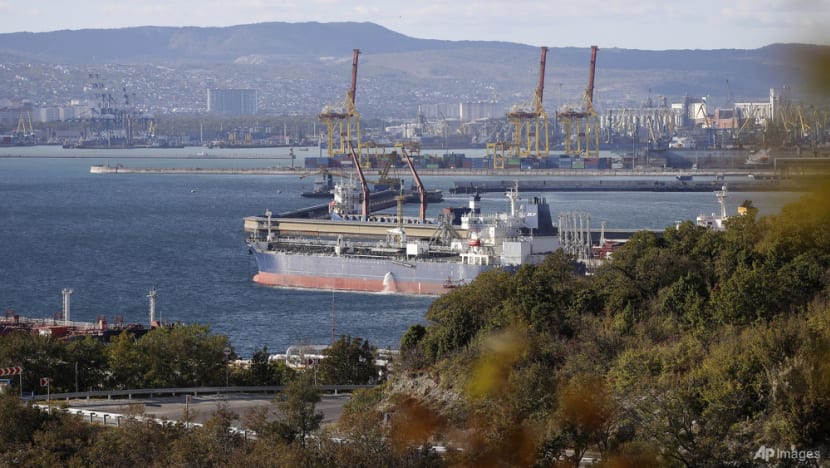CNA Explains: What we know about a hit-and-run off Pedra Branca involving an alleged ‘dark ship’
The vessel is said to be part of a fleet which intentionally - and illegally - disables their location trackers.


This audio is generated by an AI tool.
Update: Malaysian authorities said on Tuesday (Jul 30) that Ceres I did not flee the scene but drifted away as an anchor chain was cut off during the collision.
SINGAPORE: Earlier in July, the Singapore-flagged tanker Hafnia Nile and Sao Tome and Principe-flagged tanker Ceres I collided about 55km northeast of Pedra Branca island, causing both ships to catch fire.
After crew members of both vessels were accounted for and some evacuated, the Ceres I mysteriously fled the scene.
What happened?
The site of the collision was within Singapore’s maritime search and rescue region, so a nearby Singapore navy frigate responded while the Singapore air force sent a helicopter to assist with evacuations.
The Hafnia Nile crew were brought to Singapore. Two Ceres I crew members had to be sent to Singapore General Hospital, while others stayed on.
However, the Ceres I then illegally left the site and turned off its tracking system.
It was found by the Malaysian coast guard two days later, along with two tugboats towing it.
For the Hafnia Nile, Singapore last week said it was discussing with Danish shipping firm Hafnia about a safe location to transfer its cargo as well as to tow the vessel away for repairs.
Both Malaysian and Singapore authorities are investigating the incident.

How did it happen?
The Hafnia Nile was en route to Kashima, Japan, and moving at 14.2 knots when the collision happened, according to automatic identification system (AIS) data.
The AIS provides information on the identity and location of all ships.
The 228m-long and 32m-wide tanker was carrying up to 60,000 metric tonnes of naphtha, a highly flammable mixture used to make petrochemicals, according to data from analytics firm Kpler.
AIS data meanwhile showed the 330m-long and 60m-wide Ceres I moving at zero knots at the time.
The National University of Singapore (NUS) law faculty’s Emeritus Professor Robert Beckman said AIS spoofing may have contributed to Ceres I colliding with the Hafnia Nile.
The practice involves the deliberate manipulation of AIS data to disguise the actual location of the ship, explained Prof Beckman, who co-heads an ocean law and policy programme at the university.
In a LinkedIn post, maritime information service Lloyd's List Intelligence's principal analyst Michelle Wiese Bockmann called Ceres I a "serial spoofer".
Its AIS records before the collision showed an unchanged or identical course and speed for long periods, an improbability given navigation and weather adjustments, she added.
Why would Ceres I be spoofing?
Prof Beckman pointed to maritime journal reports of the Ceres I shipping sanctioned Iranian and Russian oil over the past five years, and engaging "in a range of dangerous and deceptive shipping practices”.
That would render the tanker as what’s known as a "dark ship" and part of a “dark fleet”, which employs illicit or evasive tactics to transport across the world oil from countries subject to global sanctions, he explained.
Operated by China’s Shanghai Prosperity Ship Management, Ceres I is categorised as a very large crude carrier (VLCC) - among the biggest out there, and capable of carrying around two million barrels.
Kpler data showed the Ceres I carrying cargo from Iran and Venezuela earlier this year and the last.
Ceres I also discharged heavy Iranian crude in the waters off eastern Malaysia around June, according to Ms Bockmann.
“The area is well-known for storage and ship-to-ship transfers of sanctioned Iranian, Venezuelan and Russian oil destined for China,” she noted.
Iran’s Ministry of Petroleum has issued a statement saying the Ceres I was not carrying Iranian crude oil.

What else do we know about dark ships?
Lloyd’s List defines a ship as part of the dark fleet if it's aged 15 and above; anonymously owned; solely used in trades relating to sanctioned countries; and engaging in deceptive shipping practices.
Apart from spoofing, these include outright disabling AIS transponders to “go dark” and be undetected, to move the commodities illegally.
Dark ships avoid inspection by not entering ports where they may be subject to checks.
To avoid the regulatory reach of coastal states, they anchor outside territorial sea limits of 12 nautical miles, and carry out ship-to-ship transfers in exclusive economic zones.
Dark ships are also characterised by their use of multiple “flags of convenience” over short periods of time, said maritime risk management firm Windward.
International law requires merchant ships to be registered in a host country. A flag of convenience refers to when a ship is registered in a different country than the one where its owner resides or holds citizenship.
Flags of convenience thus at times allow shipowners to remain legally anonymous, making it difficult to take civil or criminal legal action against them.
Due to the low oversight, flags of convenience have also been used to hide criminal activities such as drug and human trafficking or illegal fishing.
Ceres I has over the years changed its flag multiple times, registering with Honduras, Panama, Liberia, Marshall Islands and now Sao Tome and Principe.
Panama is particularly popular as it offers online registration and doesn't levy an income tax on foreign owners, explained Windward.
Prof Beckman said estimates of strength of the dark fleet range from 600 to 1,400.
“The oil-exporting states that are subject to international sanctions are likely to be supporting the dark fleet,” he said.
Russia, for one, has reportedly used dark ships to work around the West’s efforts to constrain it after the invasion of Ukraine.

Just how dangerous are dark ships?
Their evasive tactics could create misleading or dangerous situations.
And any collision is a potential risk to human life, especially if it involves vessels carrying oil products, Kpler’s lead crude analyst Viktor Katona told CNA.
Naphtha - carried by the Hafnia Nile - is much more flammable than crude, so it was "genuine luck" its collision with Ceres I didn't lead to a catastrophe, he added.
Dark ships are also not responsive and cooperative when such incidents occur - as seen in Ceres I fleeing the scene - which in turn threatens the safety and lives of crew.
Prof Beckman noted that sailors onboard dark ships are typically recruited from third-world countries by unscrupulous agents. They might not be aware that they are working on an unsafe and unregulated tanker, he said.
Then there is the risk of oil spills from collisions and groundings, and what it would do to the marine environment.
Aerial surveys had found an oil spill covering five square nautical miles at the scene of the collision between Ceres I and Hafnia Nile.
“The pollution issue is exacerbated because most of the tankers in the dark fleet do not have liability insurance for oil pollution damage to coastal states,” said Prof Beckman, noting that such insurance is in fact required by International Maritime Organization (IMO) conventions.
The advanced age of dark ships - almost 70 per cent of them are older than 15 - also makes them more likely to be in poor condition and prone to accidents, said Windward.
The Ceres I was built in 2001, making it 23 years old.

What can authorities do about them?
The IMO’s legal committee discussed the issue of dark ships in March last year, after it was told that hundreds of tankers were circumventing sanctions and high insurance costs.
In December, the IMO adopted a resolution urging member states and stakeholders to take steps to prevent the illegal operations of the dark fleet.
Prof Beckman said tougher legislation could help to combat the problem.
The long-term solution is for laws and regulations to mandate that oil tankers be registered only in states that can and will ensure the ships fully comply with IMO conventions, he said.
These span safety of navigation, preventing pollution from ships and ensuring regular inspections.














